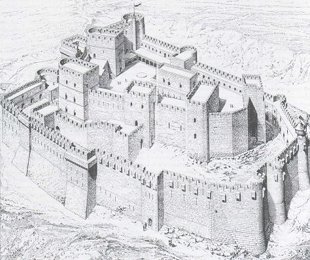Concentric Castles
Explain how Europe benefited from cultural diffusion during the period c. A.D. 1000 - 1500.

Crusader Castle Krak des Chevaliers
A concentric castle (or multiple castle) is a castle within a castle, with two or more concentric rings of curtain walls and, in some cases, no central keep. The walls would include towers and bastions and would usually be crenellated. Gates would usually be protected by barbicans.
A concentric castle is a much larger construction than Motte and Bailey or Stone Keep Castles. Concentric Castles, such as Beaumaris and Caerphilly Castles, make best use of angles in a castles design, providing the defender with more opportunity to hurt any attacking force.
The typical design of a concentric castle, as in the image to the left, has two walls. The first of the walls is a low curtain wall with a number of defensive towers; the inner wall was raised higher so that defenders would fire over the top of the outer wall.

Diagram of Beaumaris Castle
Each of the walls has a variety of rounded towers from which a defender has a number of vantage points over his assailant. Once inside the outer curtain wall any intruder would be visible to archers or crossbowmen within up to 8 of the towers and along the walls.
To successfully capture the castle they would also have to either scale both sets of walls, under fire from each of the towers, or breach the heavily fortified gatehouses. In addition to the number of curtain walls and towers the castle was, usually, surrounded by water, making attack even more perilous.
In pure architectural terms, Beaumaris, the most technically perfect castle in Britain, has few equals.
Its ingenious and perfectly symmetrical concentric walls within walls
design, involving no less than four
successive lines of fortifications, was state of the art for the late 13th century.

Beaumaris Castle
Major advantages of a Concentric Castle:
- Round towers could not be mined as easily.
- Larger castles can house a greater number of defendants.
- Once inside the outer wall an attacker was still visible to defenders in a large number of towers.
- The symmetrical design ensures that entry to the inner most parts of the castle is closely monitored.
- Low curtain walls mean that defenders on the inner and outer walls can see attackers.
- A small number of men could defend a large part of the castle.
